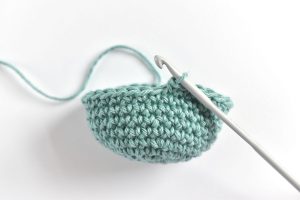The world of amigurumi, the art of crocheting adorable stuffed animals, offers endless possibilities for crafty minds. Whether you’re a seasoned crocheter or just picking up your first hook, creating a cuddly companion can be a delightful and rewarding experience. This guide will walk you through the essentials of crocheting amigurumi animals, equipping you with the knowledge and confidence to bring your own fuzzy friends to life.
Gearing Up: Tools and Materials
Before diving into the world of amigurumi, let’s gather the necessary supplies.
- Crochet Hook: Choose a hook size appropriate for your chosen yarn weight. Generally, a smaller hook creates tighter stitches, resulting in a firmer amigurumi. Conversely, a larger hook creates looser stitches and a softer toy.
- Yarn: Select yarn that is soft and cuddly, perfect for snuggling. Cotton or acrylic yarns are popular choices for amigurumi as they are durable and come in a vast array of colors.
- Stuffing: Polyester stuffing is the go-to choice for amigurumi. It provides a lightweight and fluffy filling for your creations.
- Tapestry Needle: This helps sew together amigurumi pieces and embroider facial features.
- Scissors: Sharp scissors are essential for snipping yarn ends and shaping details.
- Safety Eyes (Optional): These pre-made eyes offer a secure and realistic option for your amigurumi. Alternatively, you can embroider eyes with yarn.

Mastering the Basics:
Now that you have your supplies in hand, let’s explore some fundamental crochet techniques used in amigurumi.
- Single Crochet (SC): This is the foundation stitch for most amigurumi patterns. You’ll insert your hook into a stitch, yarn over, pull a loop through, yarn over again, and pull through both loops on your hook.
- Increasing: This creates additional stitches in your round, shaping your amigurumi. There are different increase techniques, but most beginner patterns will utilize single crochet increases.
- Decreasing: This reduces stitches in your round, typically used to close or shape your amigurumi. Similar to increases, various decreasing methods exist, with single crochet decreases being common in beginner patterns.
- Crocheting in the Round: Most amigurumi pieces are crocheted continuously in a spiral, rather than rows. This creates a seamless body for your stuffed animal.
- Fastening Off: When you’ve finished crocheting a piece, you’ll need to secure your stitches with a slip stitch or by weaving the yarn tail through the last few stitches.

Choosing Your Perfect Pattern:
With the basics covered, it’s time to find the perfect amigurumi pattern! There are countless free and paid patterns available online and in craft books. Here are some tips for selecting a beginner-friendly pattern:
- Skill Level: Choose a pattern clearly labeled as “beginner” or “easy.”
- Complexity: Simpler shapes like spheres, ovals, and cylinders are easier to manage for first-time amigurumi crocheters.
- Animal Selection: Pick an animal with a design that appeals to you. Consider factors like the number of pieces and how detailed the features are.

Let’s Get Crocheting!
Now that you have your tools, basic techniques down, and a chosen pattern, it’s time to start crocheting! Here’s a general outline of the amigurumi creation process:
- Start with a Magic Ring: This creates a hole-free center point for your amigurumi.
- Follow the Pattern: The pattern will guide you through increasing and decreasing stitches to form the body and features of your animal.
- Stuffing: As you crochet, periodically stuff the piece to maintain its shape.
- Assembly: Once all the pieces are crocheted, sew them together using your tapestry needle and yarn.
- Embellishments: Embroider details like eyes, noses, and mouths. You can also add buttons, ribbons, or other embellishments for extra personality.
Troubleshooting Tips:
Don’t be discouraged if you encounter challenges along the way. Here are some common issues and solutions for amigurumi crocheters:
- Uneven Stitches: Practice maintaining consistent tension in your yarn as you crochet.
- Gaps Between Stitches: Use a smaller hook size or crochet tighter to close up any gaps.
- Losing Your Place: Use stitch markers to keep track of rounds or specific sections of your pattern.

Beyond the Basics:
As you gain experience, you can explore more intricate patterns and techniques. Here are some ways to expand your amigurumi horizons:
- Colorwork: Incorporate multiple yarn colors to create stripes, patterns, or realistic animal markings.
- Shape Techniques: Learn methods like shaping legs, tails, and ears to create more lifelike amigurumi animals.
- Wire Armatures: For added stability or poseable features, consider using pipe cleaners or craft wire as armatures inside your amigurumi.
- Advanced Stitches: Explore techniques like double crochet, slip stitch, and invisible decreases to create more intricate details.
Cleaning and washing instructions for crochet animals
Those adorable crocheted animals deserve some TLC just like any other stuffed friend! Here’s how to keep your amigurumi creations clean and fresh:
General Cleaning:
- Spot Cleaning: For minor dirt or stains, use a damp cloth with a gentle laundry detergent. Dab the affected area lightly and avoid scrubbing. Let it air dry completely before storing.
- Dry Brushing: For loose dust or pet hair, use a soft brush to gently remove debris from the surface of your amigurumi.
Washing:
- Check the Yarn Label: Always prioritize the yarn manufacturer’s care instructions. They’ll specify if the yarn is machine washable or requires hand washing.
- Hand Washing (Recommended): Fill a sink with lukewarm water and a mild detergent suitable for delicates. Gently swish your amigurumi for a few minutes. Rinse thoroughly with clean water and squeeze out excess water without wringing.
- Machine Washing (Use with Caution): If the yarn label allows machine washing, place your amigurumi in a mesh laundry bag. Use a gentle cycle with cold water and mild detergent. Avoid using the dryer setting.
Drying:
- Never use a clothes dryer! The heat can damage the yarn and cause your amigurumi to shrink or lose its shape.
- Air Drying: Lay your amigurumi flat on a clean towel in a well-ventilated area away from direct sunlight. Reshape it gently as needed while drying. You can also stuff it with a clean, dry towel to help it maintain its form.
Additional Tips:
- Safety Eyes: If your amigurumi uses plastic safety eyes, be extra cautious during washing. Consider removing them if possible and hand-washing them separately.
- Heavy Dirt or Stains: For stubborn stains, consult a professional cleaning service specializing in delicate items.
By following these simple cleaning and care tips, you can ensure your adorable crocheted animals stay clean, cuddly, and loved for years to come!

Embrace the Journey
Crocheting amigurumi is a journey of creativity and exploration. Don’t be afraid to experiment, make mistakes, and learn from them. The most important thing is to have fun and enjoy the process of bringing your cuddly creations to life. Here are some additional resources to support your amigurumi adventure:
- Online Crochet Communities: Join online forums or groups dedicated to crochet and amigurumi. These communities offer valuable support, inspiration, and opportunities to share your work and learn from others.
- Crochet Video Tutorials: Many websites and YouTube channels offer video tutorials specifically for amigurumi projects. Visual demonstrations can be incredibly helpful, especially for beginners.
- Craft Books and Magazines: Invest in books and magazines dedicated to crochet and amigurumi. These resources provide a wealth of patterns, techniques, and inspiration.
With dedication and practice, you’ll be crocheting adorable amigurumi animals in no time. So grab your hook, yarn, and creativity, and get ready to embark on a delightful journey into the world of amigurumi!


